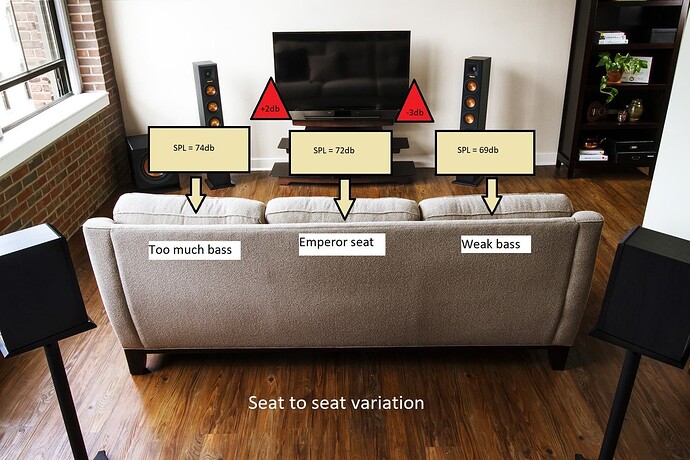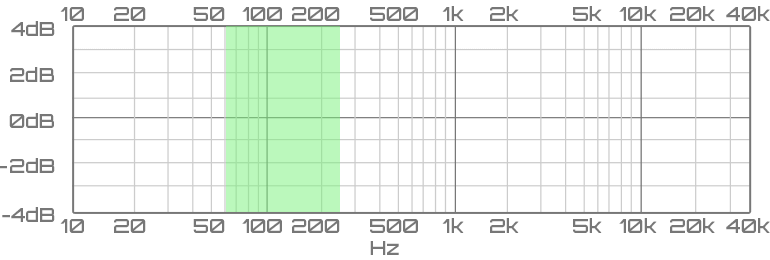This is a simple tutorial tailored for those who have multiple seats - e.g. a 2 or 3 seater sofa. If you are like me who desire consistency in bass output for all seats, you may want to give this a shot. It works for me, and I hope it works for you as well.
Caveat #1
This works for two or more subwoofers only. This is not applicable to a single subwoofer setup. If you have 4 subwoofers placed at an equidistant to your Main Listening Position (MLP), then your seat-to-seat variation should be minimal. Instead, you should focus more on time-aligning the subwoofers using REW. But this is not what we are here for…
The image depicted above is for illustration purposes. Let’s assume that there is another “phantom subwoofer” that existed diagonally at the rear of the setup, making it a dual subwoofer setup. In my case, I have 3 JL Audio subwoofers – 1 pair of E112 in front and a E110 at the rear right of my seat, making it a challenge to get an even response, let alone a good and uniform SPL reading.
Many of us have spent time to time-align to get an even frequency response and then bump up a few dB (increase in output) from 15Hz to the 120Hz range to get that “house curve”. And that’s all good but what happens if you are sitting near to a subwoofer, say on the “Too much bass” seat on the left? What you get is amplified by 2db due to the room mode and the position of your seat. Conversely, you will get a weaker bass if you are sitting on the right side of the sofa couch. The “Emperor seat” gets all the best stuff because you are the one who spent the money and the man-hours to get the family dream home theatre set up. But let’s say you are feeling generous and you want all seats to sound and feel “good”. The way around it is of course to get all SPL readings to read 72db (single subwoofer will be tuned at 75db while dual subwoofer setup will be tuned to around 72db so the summation of both subwoofers will get you around the output of 75db) for all 3 seats. This is challenging but not mission impossible. Here’s what you need to do:
Getting the SPL readings
First, switch off the rear subwoofer and focus only on the front subwoofer for now. If you have a REW with UMik 1, you can use the built-in SPL meter and pink noise generator for the subwoofer calibration to play a sine tone of 50Hz and take a measurement of the SPL reading at each seat location. Ideally, all 3 seats should read 72db but more often than not, this will not be the case due to the proximity of the seat to the physical subwoofer, the layout of your décor, furniture, and walls. This will create a “unique” room mode that will ultimately have an impact on the SPL readings.
The trick here is not to make the “Emperor seat” read 72db and instead lower the gain knob on your front subwoofer to read about 72db. Of course, this will ultimately cause the SPL reading to drop for the middle seat and the right seat. It is ok. What you are trying to do here is to ensure the “Too much bass” seat reading will always get reference level at 72db in order to attenuate the overbearing bass effect. While the “Emperor seat” may register a drop in SPL reading, it will not have a very big impact. Proceed to take the readings for the middle and the right seat as well. Do not worry too much about the SPL readings, for now, just make a cursory check to ensure the drop in readings is well within the reasonable 3 – 6 dB range.
Once we are done with the front subwoofer, we will move on to the rear subwoofer. Before that, remember to turn off the front subwoofer. Recall the rear subwoofer is placed at the rear right of the sofa, hence the right side will now register a higher SPL compared to the middle and the left seat (opposite of what we get when we measure the front left subwoofer placement). So the same method applies, just make sure the SPL reading for the right seat measures at 72db and take a cursory reading for the middle and the left seat.
Next, fire up both subwoofers and take a measurement for all the seats. You will see variations when both subwoofers are fired up due to the interactions of the room mode. So long as the readings fall within the 3 – 6db deviation, you are alright.
Caveat #2
Proper subwoofer placement still plays a large part here. For 2 subwoofers, the preferred layout should be one at the front and the other at the rear of the MLP. Whenever possible, do a diagonal placement for 2 subwoofers, meaning one on the front left while the rear subwoofer will be placed at the right rear or vice versa. I have personally tested the placement of 2 subwoofers at the front (at 0-degree polarity) and it does not yield a good frequency response relative to the MLP unless you move your seat to compensate for any peak and nulls created by your room. More trial and error need to be done. To overcome the guesswork, I highly recommend everyone to use the Harman Room Mode Calculator (HARMAN International). I have been using it extensively over the years to help me determine the optimum seating distance relative to my subwoofers. This calculator is extremely useful for beginners and advanced users to help understand your room mode better so that you know where and how far (in distance) to place your sofa and subwoofers. Remember, placement of your speakers and subwoofers relative to your MLP is extremely critical to take the guessing out of the equation when you set up your home theatre. Once you have the foundation set and know exactly where to put your “Emperor seat” and where to place your subwoofers, room calibration and aftermath EQ’ing will be at its minimum. There is literally no need for miniDSP if you have a solid “ground foundation”. The only time you need it is due to the imperfections that are present in your ground foundation. Proper placement of the speakers, subwoofers, and your MLP take up 70% while any form of room EQ calibration will take care of the 20%. 10% will be allotted to acoustic treatment. My mantra is to get it “right” the first time and every time.
Bass “level output” tuning
Now comes the part to tune the bass evenly. For this exercise, you do not need REW anymore. The REW and SPL combo can only do so much. It set the foundation right and provides you an average SPL reading at different seats, to better understand the way your subwoofers interact with your room relative to your MLP. Forget about the various sine wave test tones as it will not help you in getting an even bass output (notice the emphasis is on tangible levels of output, something you will hear and feel and not the actual SPL reading) at your seats.
The real tuning begins with listening to a good “bass-looping” track that you are familiar with. Choose a track with a good amount of bass range from bass to low-midrange (60Hz – 500Hz) and not the sub-bass range (20Hz – 60Hz).
I highly recommend Jesse Harris’s Mizayaki soundtrack (short but looping). You can download the clips from Youtube here: Jesse Harris with Star Rover - "Miyazaki" (Live at Dangerbird) - YouTube
Before you start, if your subwoofers are in the front and rear layout arrangement, make sure to switch one of the subwoofers to “180 degrees” (inverse) for your polarity while the other at “0 degrees (normal). In gist, what this does for the subwoofer driver with inverse polarity to move in the opposite direction of the main speaker drivers when content is being played while normal polarity will move in tandem with the main speaker drivers.
Next, set the phase control knob to around 45 degrees as a good starting point for both subwoofers. With the soundtrack playing, take turns to cycle between the left and the right seats. Use your ears to “hear” and “feel” the soundtrack as you slowly make minor adjustments to the phase control on both subwoofers. You will know you get it right when you start to “perceive” the same level of loudness and full body of the soundtrack for all seats. The “Emperor seat” will be averaged out and you will still get the best sound/bass experience while your wife and children will also get to share the fruit of your labor and investments.
Demo Time!
Fire up some of your familiar movies with bass like Ready Player One or the clips from my XP Demo Disc 8 and test out all the scenes. Make finer adjustments along the way if you need.
Try it out during one of the weekends or your off days and you will appreciate what this brings to you and your family.


